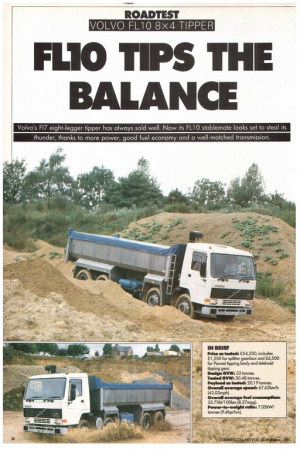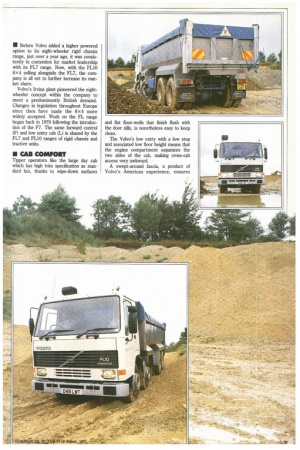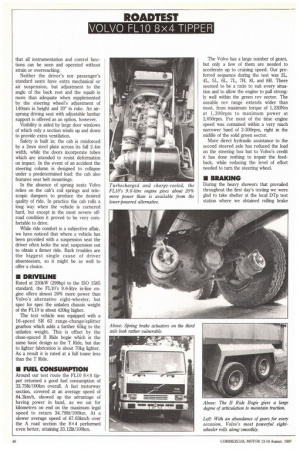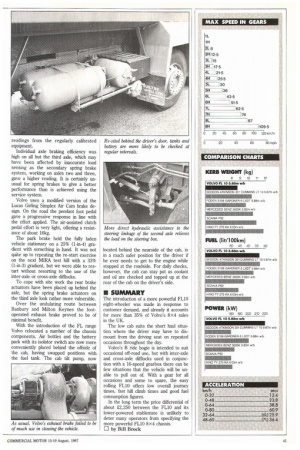FL10 TIPS THE BALANCE
Page 40

Page 41

Page 42

Page 43

If you've noticed an error in this article please click here to report it so we can fix it.
Volvo's FI7 eight-legger tipper has always sold well. Now its FL 0 stablemate looks set to steal its thunder, thanks to more power, good fuel economy and a well-matched transmission. • Before Volvo added a higher powered option to its eight-wheeler rigid chassis range, just over a year ago, it was consistently in contention for market leadership with its FL7 range. Now, with the FLIO 8x4 selling alongside the FL7, the company is all set to further increase its market share.
Volvo's Irvine plant pioneered the eightwheeler concept within the company to meet a predominantly British demand. Changes in legislation throughout Europe since then have made the 8x4 more widely accepted. Work on the FL range began back in 1978 following the introduction of the F7. The same forward control (F) and low entry cab (L) is shared by the FL7 and FLU) ranges of rigid chassis and tractive units.
II CAB COMFORT
Tipper operators like the large day cab which has high trim specification as standard but, thanks to wipe-down surfaces and flat floor-wells that finish flush with the door sills, is nonetheless easy to keep clean.
The Volvo's low entry with a low step and associated low floor height means that the engine compartment separates the two sides of the cab, making cross-cab access very awkward.
A swept-around fascia, a product of Volvo's American experience, ensures that all instrumentation and control functions can be seen and operated without strain or overreaching.
Neither the driver's nor passenger's standard seats have extra mechanical or air suspension, but adjustment to the angle of the back rest and the squab is more than adequate when supplemented by the steering wheel's adjustment of 140mm in height and 200 in rake. An airsprung driving seat with adjustable lumbar support is offered as an option, however.
Visibility is aided by large door windows of which only a section winds up and down to provide extra ventilation.
Safety is built in; the cab is reinforced by a 2mm steel plate across its full 2.4m width, while the doors incorporate tubes which are intended to resist deformation on impact. In the event of an accident the steering column is designed to collapse under a predetermined load: the cab also features seat belt mountings.
In the absence of sprung seats Volvo relies on the cab's coil springs and telescopic dampers to produce the desired quality of ride. In practice the cab rolls a long way when the vehicle is cornered hard, but except in the most severe offroad condition it proved to be very comfortable to drive.
While ride comfort is a subjective affair, we have noticed that where a vehicle has been provided with a suspension seat the driver often locks the seat suspension out to obtain a firmer ride. Back troubles are the biggest single cause of driver absenteeism, so it might be as well to offer a choice.
• DRrVELINE
Rated at 220kW (299hp) to the ISO 1585 standard, the FL10's 9.6-litre in-line engine offers almost 20% more power than Volvo's alternative eight-wheeler, but spec for spec the unladen chassis weight of the FL10 is about 430kg higher.
The test vehicle was equipped with a 16-speed SR 62 range-change/splitter gearbox which adds a further 65kg to the unladen weight. This is offset by the close-spaced B Ride bogie which is the same basic design as the T Ride, but due to lighter fabrication is about 70kg lighter, As a result it is rated at a full tonne less than the T Ride.
• FUEL CONSUMPTION
Around our test route the FL10 8x4 tipper returned a good fuel consumption of 33.751k/100km overall. A fast motorway section, covered at an average speed of 84.31m/h, showed up the advantage of having power in hand, as we sat for kilometres on end on the maximum legal speed to return 34.791it/100km. At a slower average speed of 67.63krn/h over the A road section the 8x4 performed even better, attaining 33.121it/100km. The Volvo has a large number of gears, but only a few of them are needed to accelerate up to cruising speed. Our preferred sequence during the test was 2L, 4L, 5L, 6L, 7L, 7H, 8L and 811. There seemed to be a ratio to suit every situation and to allow the engine to pull strongly well within the green rev sector. The useable rev range extends wider than most, from maximum torque of 1,230Nm at 1,300rpm to maximum power at 2,050rpm. For most of the time engine speed was contained within a very much narrower band of 2-300rpm, right in the middle of the solid green sector.
More direct hydraulic assistance to the second steered axle has reduced the load on the steering box but to Volvo's credit it has done nothing to impair the feedback, while reducing the level of effort needed to turn the steering wheel.
• BRAKING
During the heavy showers that prevailed throughout the first day's testing we were glad to take shelter at the local DTp test station where we obtained rolling brake readings from the regularly calibrated equipment.
Individual axle braking efficiency was high on all but the third axle, which may have been affected by inaccurate load sensing as the secondary spring brake system, working on axle's two and three, gave a higher reading. It is certainly unusual for spring brakes to give a better performance than is achieved using the service system.
Volvo uses a modified version of the Lucas Girling Simplex Air Cam brake design. On the road the pendant foot pedal gave a progressive response in line with the effort applied. The air-assisted clutch pedal effort is very light, offering a resistance of about 16kg.
The park brake held the fully laden vehicle stationary on a 25% (1-in-4) gradient with something in hand. It was not quite up to repeating the re-start exercise on the next MIRA test hill with a 33% (1-in-3) gradient, but we were able to restart without resorting to the use of the inter-axle or cross-axle diffiocks.
To cope with site work the rear brake actuators have been placed up behind the axle, but the spring brake actuators on the third axle look rather more vulnerable.
Over the undulating route between Banbury and Milton Keynes the footoperated exhaust brake proved to be of minimal benefit.
With the introduction of the FL range Volvo relocated a number of the chassis components. Air bottles and the battery pack with its isolator switch are now more conveniently placed behind the offside of the cab, having swapped positions with. the fuel tank. The cab tilt pump, now located behind the nearside of the cab, is in a much safer position for the driver if he ever needs to get to the engine while stopped at the roadside. For daily checks, however, the cab can stay put as coolant and oil are checked and topped up at the rear of the cab on the driver's side.
SUMMARY
The introduction of a more powerful FL10 eight-wheeler was made in response to customer demand, and already it accounts for more than 35% of Volvo's 8x4 sales in the UK.
The low cab suits the short haul situation where the driver may have to dismount from the driving seat on repeated occasions throughout the day.
Volvo's B ride bogie is intended to suit occasional off-road use, but with inter-axle and cross-axle diffiocks used in conjunction with a 16-speed gearbox there can be few situations that the vehicle will be unable to pull out of. With a gear for all occasions and some to spare, the easy rolling FL10 offers low overall journey times, fast hill climb times and good fuel consumption figures.
In the long term the price differential of about £2,250 between the FL10 and its lower-powered stablemate is unlikely to deter many operators from specifying the more powerful FL10 8x4 chassis.
LI by Bill Brock












































































